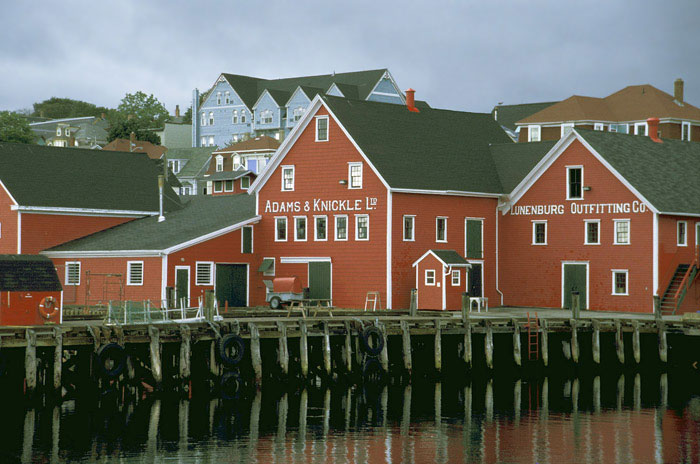
© 2011 Mike Goldstein. All Rights Reserved.
On a dark day, those traditional red buildings on the Lunenburg waterfront photograph beautifully. Film shooters would call this a “Fuji Velvia moment”! That’s exactly the film I used for this shot. Five minutes after making this image, it “was raining cats and dogs.”
The wind gusts again, and I hold firm to the wheel, in an ongoing attempt to keep the Eastern Star on course. It’s blowing twenty-five knots out of the west, and we’re carrying far too much sail for the present conditions.
Watching this little boat sailing tourists around Lunenburg harbor, on the south coast of Nova Scotia, she looks pretty as a picture. However, today she handles like a pig. This ketch has excessive “weather helm”, which means she constantly wants to stick her bow up into the breeze. It’s taking a good part of my strength to prevent that.
Out on the deck, I can see my wife, Allison, bravely holding on to her hat, and trying not to slide over the side. The boat is heeling at almost thirty degrees, and anything not firmly secured (including my camera bag, and the crowd of tourists enjoying a sailing adventure) will go into cold Atlantic waters.
Allison and I are here for a couple of days, to again sample the nautical delights of this attractive town, a regular stop whenever we head home from Toronto to top up our salt levels. Lunenburg is one of those photographic delights, found on the Atlantic coast, full of rustic architecture, brightly painted warehouses, great seafood restaurants, delightful hotels, and salty history.
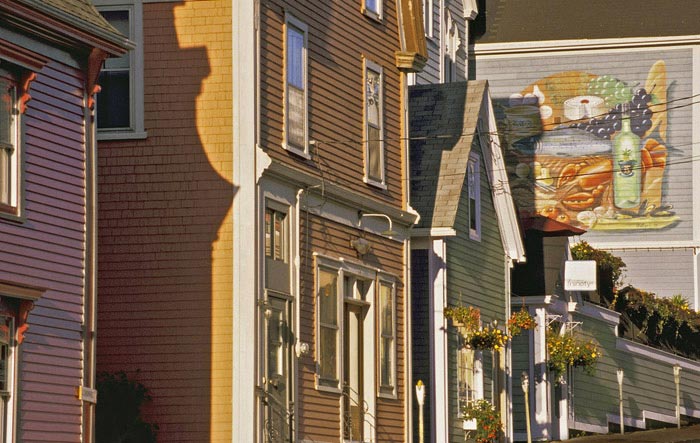
© 2011 Mike Goldstein. All Rights Reserved.
The foreshortening effects of using a telephoto lens can be nicely employed along town streets in places like Lunenburg, compressing a variety of architecture into one frame. These wooden buildings, all painted in a variety of colors, seem to glow in the morning sunshine.
Ah, yes, salty history. A local shipyard, Smith and Rhuland, built the original Bluenose sailing schooner, in 1921, now world famous.
Bluenose II, built in the same yard in 1963, was originally produced for the Oland Brewery of Halifax, we were told, as an advertising vehicle for their “Schooner Beer”. She was later adopted by the Province of Nova Scotia, and spent almost fifty years representing the Province, until her hull began to fail.
Smith and Rhuland also built the replica of HMS Rose, used in the film “Master and Commander: Far Side of the World”, starring Russell Crowe, as well as the replica of HMS Bounty, used in the film “Mutiny on the Bounty”, starring Marlon Brando.
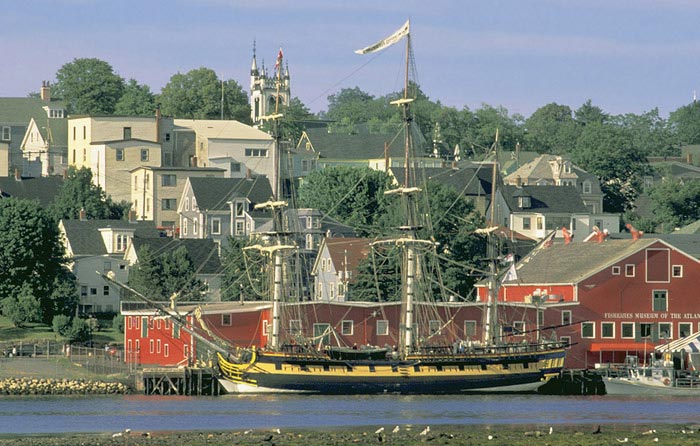
© 2011 Mike Goldstein. All Rights Reserved.
The Lunenburg skyline is easily photographed, with a short telephoto, by driving around the harbor to a small park, or up to the golf course on the hillside above the harbor. On this occasion, I caught HMS Rose, visiting Lunenburg on a Nova Scotia tour, tied up in her birthplace!
As I type this, yet another incarnation of Bluenose, new from the keel up, is being built in the same yard, now called the Lunenburg Shipyard Alliance, and scheduled to be launched later this year.
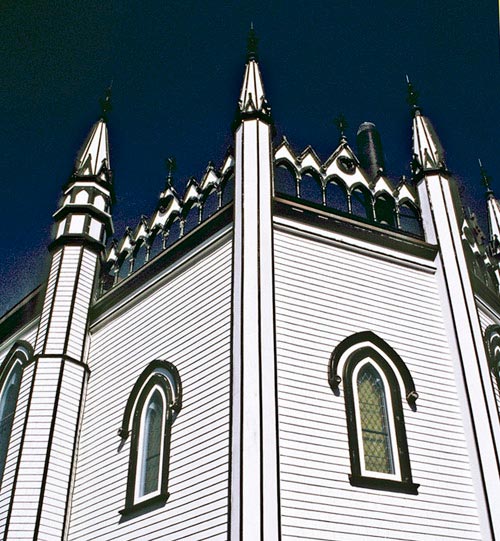
© 2011 Mike Goldstein. All rights reserved.
“Carpenter Gothic” is a much rarer sight, and St. John’s Anglican Church, in the middle of Lunenburg, is a wonderful example.
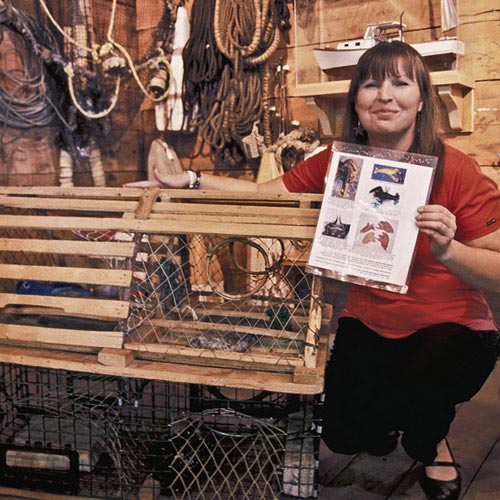
© 2011 Mike Goldstein. All rights reserved.
Lorna Ross, one of the Museum staffers, gave us, with great enthusiasm, as comprehensive a lecture on the subject as any I’ve had anywhere.
If I look across the harbor to the Lunenburg skyline, I’ll see the peaks of former ship captains’ houses, as well as those of merchants, carpenters, and smugglers. Many show the influence of Carpenter Gothic, traditional stone construction implemented in wood, courtesy of various ships’ carpenters. Gothic architecture is traditionally done in stone, and gothic cathedrals are a familiar sight in many cities around the western world. In many cases, architecture like this was created by ships’ carpenters, keeping their hands busy when not at sea. This town reeks with history.
Yesterday, we spent much of the day at the Fisheries Museum of the Atlantic, right on the waterfront. This is a fantastic attraction, with nautical exhibits for all ages, many of them very imaginative creations. It is a repository for much of the town’s history. Ship building, rum running, knots and rigging, you’ll find it all here.
For example, right on the wharf, there is a color-coded chart, showing the relative sizes of whales found in the Atlantic. Not so interesting, until you look down at your feet, and discover the same colored lines painted on the wharf surface, each line as long as the whale it represents. The blue line (for the blue whale, of course!) seems to stretch away almost to the city of Halifax, about sixty miles distant. That is a big whale! “Show and tell”, and then some.
The museum offers fascinating lectures, with “show and tell” on the lobster fishery, and how those wonderful crustaceans come to appear on your plate. Life cycle, trapping hardware, fishing fleet seasons … all you ever wanted to know.
You can view lobsters, read about lobsters, see them being trapped, then eat them at the Old Fish Factory, after you’ve photographed the sunset.
An old salt in the dory shop told us all about the reconstruction of Bluenose. He wasn’t much impressed with the efforts to ballast the hull … Lorna Ross gave us chapter and verse on the lobster fishery, and how they catch those delicious crustaceans.
Did you know that those very expensive creatures, now selling for $100 a plate in swank Toronto eateries, were once used for fertilizer, on fishermen’s front lawns? If you were a kid in school at that time, and brought out lobster sandwiches, you were classified as living below the poverty line!
We found old photos and books on the days of Prohibition, rum-running being a cottage industry around this coast, back in the day.
Those old boys were of very hardy stock, much of it of German extraction. The former Chief of Police, Hugh Corkum, a hulking six-footer, was a good friend of mine. He used to appear at our door in Halifax on a regular basis during my teenage years, to sample my mother’s coffee and bagels, and talk ham radio with me.
At a local picnic, Hugh and I once entered the “three-legged race”. When the starter’s gun went off, he picked me up bodily, and ignoring my 130-pound load, took off for the finish line. My legs never touched the ground, and we “won in a walk”!
The photo opportunities abound around Lunenburg. After I relinquish the wheel of the Eastern Star to the next passenger, I move around the deck (carefully!), using a fisheye lens to capture the feeling of a ship at sea. Diagonal lines of booms, curving sails emphasized by the lens distortion, foreground well filled with tackle or nervous tourists … this is the lens for the job!
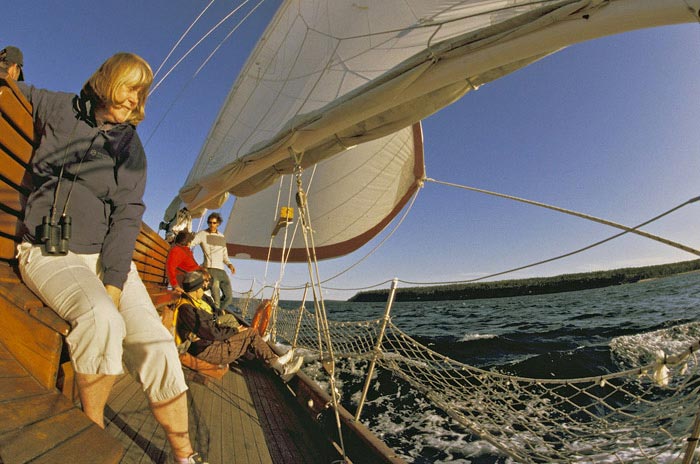
© 2011 Mike Goldstein. All Rights Reserved.
Wide – angle lenses are just the thing for putting the viewer “on the boat”, and drawing the eye into the sailing experience. It’s necessary to watch out for that “tippy horizon”, and of course, to hold on to the boat, when making images like this!
I’ve brought a good zoom telephoto with me, as well, for later grab shots around the harbor–gals rowing dories, fishermen cleaning fish, close-ups of soaring masts… lots of photo ops.
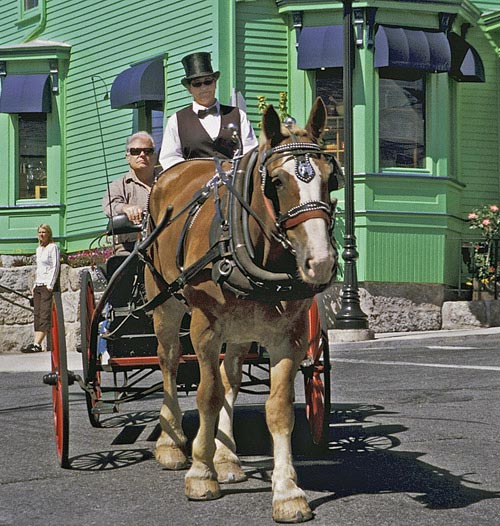
© 2011 Mike Goldstein. All rights reserved.
And if you want a bit of down time, you can let someone else take the helm so you can just sit back and enjoy a relaxing tour of old Lunenburg in the traditional fashion, clip-clopping along behind a horse. These carriages are available for rent on the waterfront, and are a favourite mode of travel for town visitors. They follow a fixed route, and it’s easy to “lie in ambush” for them, camera at the ready, once their routine has been established.
I’m looking forward to doing some mood shots, if the weather turns poorly, or the fog rolls in. The bright reds of seaside warehouses, famous in the Lunenburg skyline, will just “jump off the film” in that muted light, even if you’re shooting pixels! Later, we’ll drive across the harbor to the golf course, where “taking the high ground” gives great views of the town, across the water.
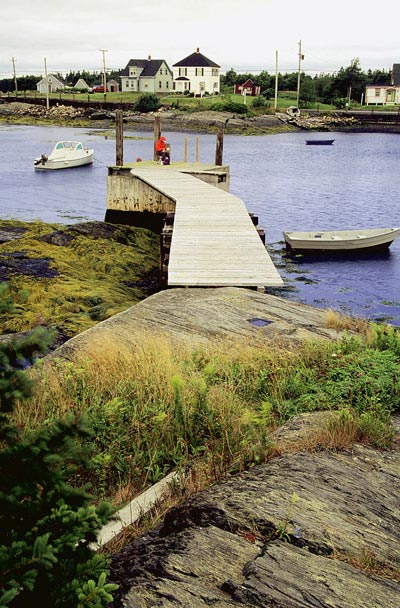
© 2011 Mike Goldstein. All rights reserved.
A wide – angle lens was used to emphasize the foreground, with Allison, wearing her customary red jacket, strategically placed to provide an accent of color.
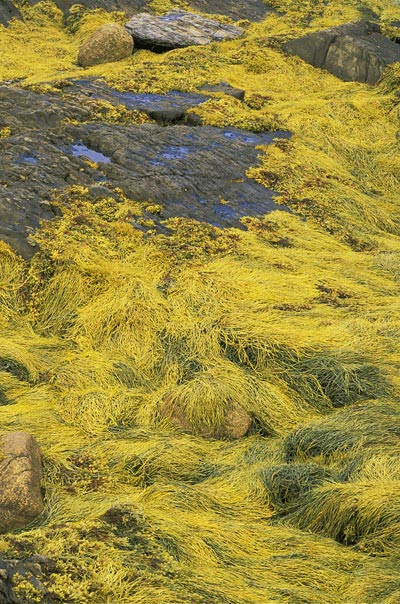
© 2011 Mike Goldstein. All rights reserved.
One of the attractive areas near Lunenburg is the community of “Blue Rocks”, an interesting misnomer, as the rocks all seem to be covered in yellow seaweed!
Close to Lunenburg, a well – known natural attraction, known as The Ovens, offers both a good walk, and some interesting photographic opportunities.
The “ovens” are actually sea caves, shaped much like the clay ovens of pioneer days. The Atlantic roars into and out of these caves, creating interesting sounds, and lots of spray on windy days.
There is a nice walk that takes you right along the cliff-top, with viewing stations and steps that give access to some of these caves.
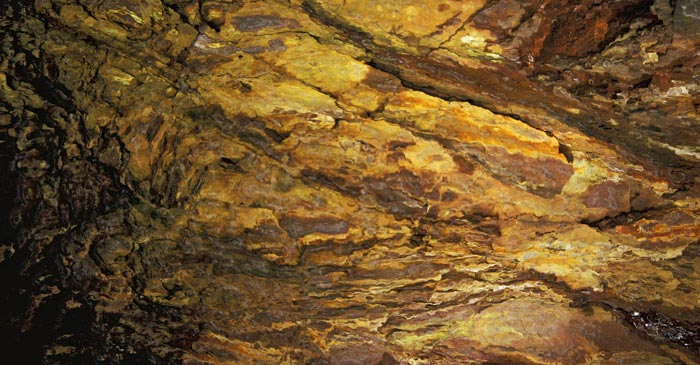
© 2011 Mike Goldstein. All rights reserved.
The rock in the caves is heavy in iron, hence the rusty appearance of the caves themselves. A wide – angle lens and a light tripod allowed me to make this image, while keeping my feet dry. Even my wife, Allison, known for her fear of heights and claustrophobic places, allowed herself to be lured inside, to enjoy such an unusual sight. (That man, he could sweet – talk the birds out of the trees! – Allison)
We’re staying at the Brigantine Inn, right on the waterfront, where our front window allows me good shots of the harbor, right from our “digs”. The pub, in the lowest level of the Inn, makes a fine retreat when the inner man needs sustenance, and we’re too tired to head out for dinner.
The architecture of Lunenburg lends itself to a variety of interesting still-life compositions for the photographer. Dandy diagonals, populations of peaks, subtle combos of colors … yummy!
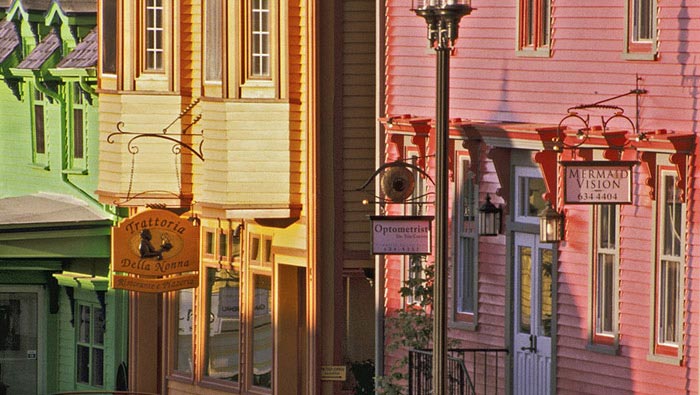
© 2011 Mike Goldstein. All rights reserved.
The bright, stunning colors of the shops are real “eye-candy” to a photographer.
The best seafood, we’ve found, is at the Old Fish Factory, attached to the Fisheries Museum, and it seems to be the only place open late enough to accommodate photographers who chase evening light.
One delightful surprise, surrounded by the Fishcake Café, the Grand Banker Seafood Grill, and the Rumrunner Inn, is the Trattoría della Nonna, a “fine dining” Italian eatery, right in the middle of town! It’s another reason to head back to Lunenburg, if only for dinner!
If you find yourself traveling to Nova Scotia, be sure to stop off in Lunenburg. You won’t be disappointed.
by Mike Goldstein

Leave a Reply